During the 1950s there were some truly odd cars around, including a luxury sports car developed by the heirs of the bobby pin fortune. Check out these crazy 50s cars! And don’t expect to see the usual suspects in this list either. Glorious luxury cars like the Bentley R-type Continental, or 1950s classics like the Ford Fairlane and Ford Thunderbird don’t make the cut either. Even the Cadillac ElDorado and other American car classics such as the Chevrolet Bel Air and Buick Roadmaster don’t get a look-in on this list. We’re after the truly weird and wonderful.

Some are the product of enthusiastic entrepreneurs and car manufacturers, others the outcome of a company at the end of the line desperately at odds with the rest of the automobile industry. Over-confidence, marketing miscalculation, and under-financed often played a role as well. Here are the weirdest automotive industry classics that could only have come from the 1950s.
1955 Gaylord Gladiator
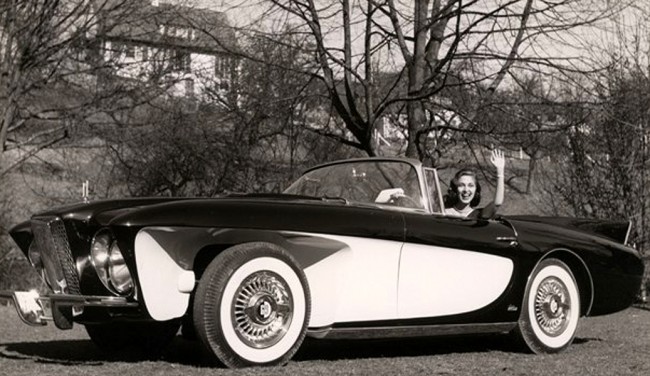
Gaylord Car Ltd. was formed by the heirs to their father’s bobby pin fortune (seriously). James and Edward Gaylord wanted to built the ultimate personal luxury performance car, which they’d name the Gladiator. To build the first prototype, they turned to Spohn coachbuilders in Germany, but they were unhappy with their work. The next group of three cars were assigned to the Zeppelin company (yep, same one) but the brothers weren’t happy with their work either. For the first year of 1955 their goal was to produce and sell 25 Gladiators at $10,000 each ($88,500 in today’s money). Despite taking deposits from movie stars and royalty, the brother just couldn’t pull the business together and gave up the effort by 1956.
1950 Studebaker Starlight Coupe
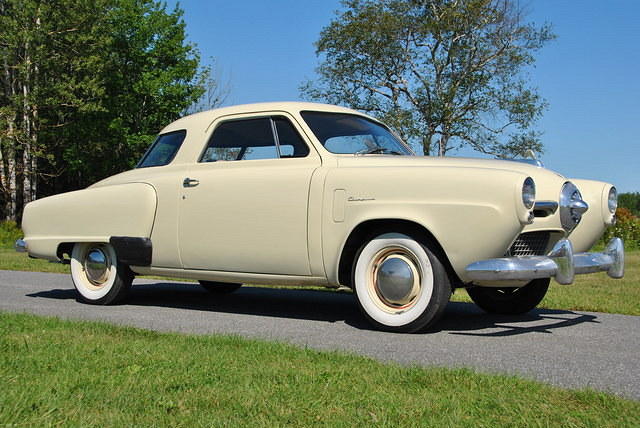
In 1950, new styling was introduced on the Studebaker Champion, with one of the new styling features the wraparound, “green-house” rear window that was on two-door cars from 1947–1951, at first just an option, in 1950 it was given its own trim line, the Starlight coupe. While great for visibility, as the C Pillar was so far forward, it created an extremely awkward looking rear section. The 1950 front wasn’t much better, with a “nose” one assumes was to look like an aircraft with a “spinner” grille that looked like it had been removed from the nacelle of a B-29. The “spinner” was dropped for the 1952 model year.
1948 Tucker 48

The Tucker 48 was an automobile conceived by Preston Tucker and briefly produced in Chicago. Only 51 cars were made before the company folded due to a Securities and Exchange Commission investigation and a heavily publicized stock fraud trial (which ended in acquittal). Though there’s plenty of rumors about why Tucker failed, in reality the design was too complicated and had too many new features for the technology and manufacturing of the time, and Tucker didn’t have the capital to properly engineer even those advanced features that made it onto the 51 cars. For example his own engine design was so heavy it took 60 volts just for the starter to turn the engine over. There were other issues with the engine as well, so helicopter engines were adapted.
1958 Packard

In 1954 the once proud Packard company had become part of Studebaker. Worst yet, by 1957 all Packard engineered cars had been dropped from the line-up. Packard now had to build cars out of whatever else Studebaker was manufacturing. So as Studebaker was calling the shots, they determined the design direction and left it to Packard to figure out afterwards how to create a unique Packard identity out of a Studebaker design (without spending an real money). What followed were some of the most ghastly cars of the 1950s. The design inspiration for the1958 Packard, in particular, must have come during a fishing trip. With the possible exception of the British Daimler SP-250 sports car, no vehicle has looked so much like a fish without intending to do so. The grille resembles a gaping fish mouth and the tail fins, well, you get it.
1958 Edsel
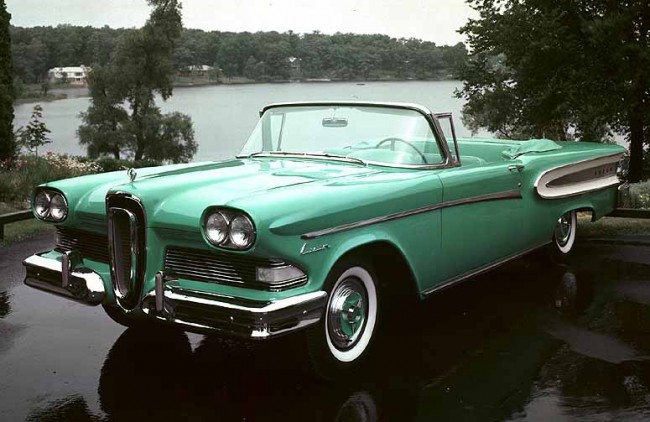
Edsel was a brand of the Ford Motor Company during the 1958 through 1960 model years. With Edsel, Ford had expected to close the gap between itself and General Motors in the domestic American automotive market. But contrary to Ford’s plans, the Edsel never established itself firmly in the marketplace. The Ford Motor Company lost millions of dollars on the Edsel’s development, manufacturing and marketing. The very word “Edsel” became a popular symbol for a commercial failure. The reasons for its failure actually had little to do with it’s styling (but it didn’t help). Nor was the name much help (Edsel was Henry Ford’s son). Primarily Edsel models were positioned so they ended up competing with Mercury models. Also the entire country was suffering through a recession. People were buying car brands that they knew at discounted prices. However, the Edsel’s most memorable design feature was its trademark “horsecollar” or toilet seat grille, which was original slim and graceful until engineers needed to open it up to accommodate more airflow into the radiator. A popular joke at the time was that the Edsel “resembled an Oldsmobile sucking a lemon”.
1956 Dodge La Femme
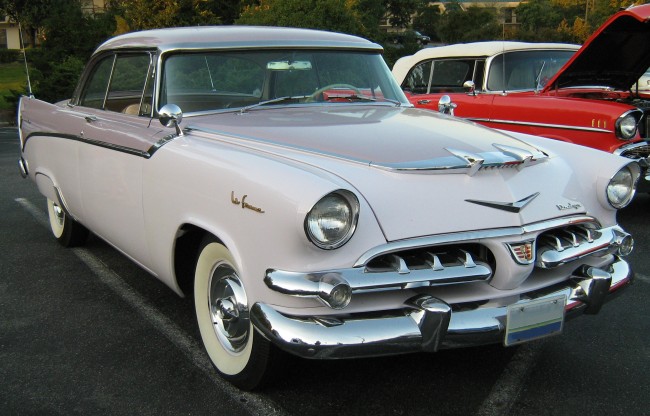
The idea for the Dodge La Femme, produced by Dodge between 1955 and 1956, came through Chrysler’s marketing department. They had observed that women’s opinions on color was becoming part of the decision making process for couples buying an automobile. So they designed an automobile specifically for women. In the advertising of the day, Dodge described the car as being “America’s most glamorous car – Designed with the ladies in mind!” As standard equipment, the 1956 La Femme came equipped with exclusive accessories: a rain cap, rain coat, and umbrella.It was offered in only one color combination — two-tone Regal Orchid over Misty Orchid. The interior was unique to the La Femme as well. It featured gold vinyl with two-tone orchid fabric inserts on the seats and door panels. It also had orchid carpet and an ivory headliner with gold colored speckles – which matched the fabric of the accessories.
1951 Muntz Jet
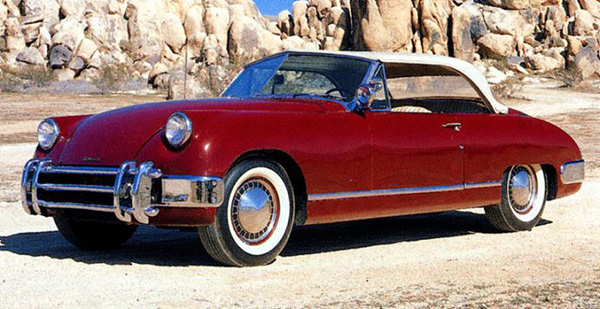
The Muntz Car Company was created by Earl “Madman” Muntz, a an LA area used car dealer and electronics retailer known for his TV commercials. In 1951, Indy Car builder Frank Kurtis sold the license to manufacture his sports car design to Muntz, who quickly renamed them the design “Muntz Jet”, extended the body and chassis to make it a four-seater, and installed a Cadillac V8. A less expensive Lincoln side-valve V8 would be installed in later cars. The car was manufactured in Chicago and featured its own unique design, with aluminum body panels and a removable fiberglass top that were manufactured in-house. The company managed to produce only about 400 cars during 1951-1954, losing about $1,000 on each car ($9,100 in today’s money). Unable to sustain the lose or envision a plan to increase sales in the future, the company was closed.
1952 Woodill Wildfire
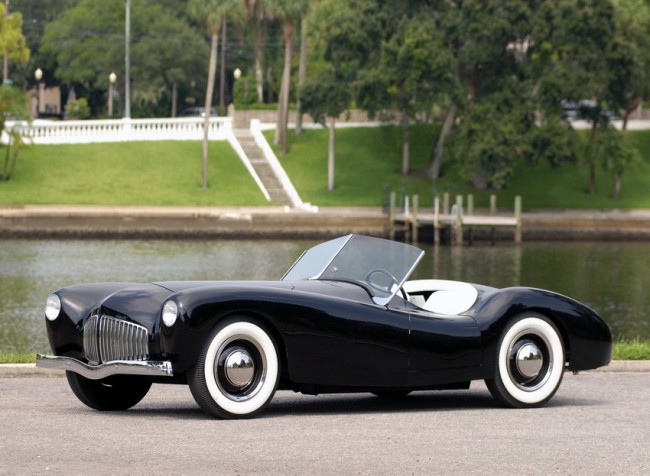
The Woodill Wildfire was an American sports car built by Dodge and Willys dealer Blanchard Robert “Woody” Woodill from 1952 to 1958 in Downey, California. The Wildfire used a Glasspar fiberglass body and a custom chassis constructed by a noted hot rod builder of the time. While intended to be a sports cars car, there was nothing sports car about it, beyond its appearance. The suspension was Willys Jeepster, with a transverse front leaf spring suspension, and a Willys solid axle in the rear. Engine was typically a Ford flathead V8. The Woodill is credited as being the first complete fiberglass car delivered with 21 factory-produced and another 285 sold as kits.
1952 Sears Allstate

Sears has been in plenty of different businesses over the years, including “kit” houses, but from 1952 through 1953 Sears sold a version of the Kaiser Henry J as an Allstate through their stores. The Allstate was distinguished from the Henry J by a number of details including Allstate badges on the hood and rear deck, more upscale interior fabrics, special wheel covers, a locking glove box and trunk lid, custom armrests and sun visors, and special parking and tail lamp assemblies. Most notably, the Allstate featured a unique two-bar grille and jet-plane hood ornament designed by Alex Tremulis, who had come to Kaiser-Frazer from the Tucker Corporation. While some Sears outlets tried to stock at least one sample of the car, most were built on demand by Kaiser-Frazer, which made delivery to the store where they were sold. Only 2,363 Allstates were sold in two model years before the marque was discontinued; 1,566 during 1952 and 797 in 1953. Kaiser soon discontinued the Henry J as well.
1950 Crosley Super Sport
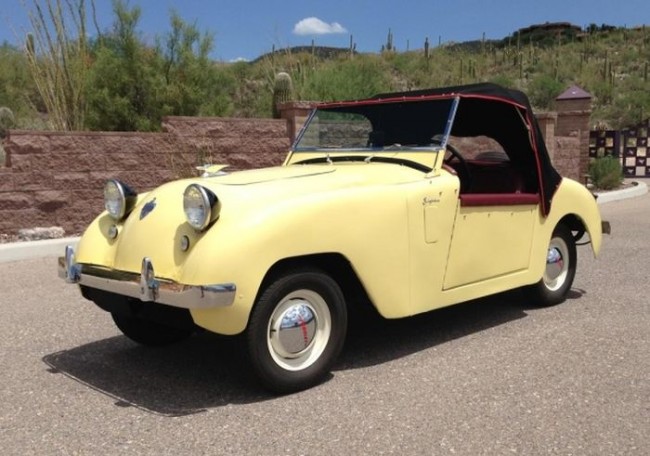
A manufacturer of appliances, Crosley entered the automotive business before WWII to sell the most inexpensive (and usually smallest) cars in America. After the war, they picked up where they left off, using a small but sophisticated OHC four cylinder developed for the US Navy. When it proved unreliable in automotive use, Crosley develop an engine around a cast iron block. The Hot Shot sports car was introduced in 1949 as a 26.5 hp version of the tiny Crosley passenger cars. In 1950, with the new engine, Crosley introduced a version of the Hot Shot with working doors called the Super Sport. Upon its introduction, the Super Sport won its class at the very first 12 Hours of Sebring. Hot Shots and Super Sports could be ordered with the Quicksilver engine option, which produced 30 hp. Unfortunately America wanted bigger cars (not smaller) in the 1950s and Crosley closed its doors in 1952.
Those were the weird and wonderful production cars to come from the decade, but what about the cars that never were? Let’s take a look at some of the most unique looking 50s concept cars that were ever dreamed up!
10 Cool Concept Cars from the 1950s
These 1950s concept cars encapsulate the spirit of the Space Age!
There were a lot of influences on the decade of the 1950s. The world was just starting to get over the horrors of World War II and they were dealing with the fears resulting from the Cold War with the Soviet Union. The Russians were the first to launch an artificial satellite into orbit around the Earth and the jolt of that feat opened all of us to the space age.
Space, that new frontier, was influencing interior design. Ceiling lamps looked like the Russian satellite Sputnik that was launched in October 1957 and, as you can see here, futuristic car concepts resembled rockets or jet fighters.
What do you think? Did the designers nail it or have these concepts that once wowed only elicit a yawn today. Scroll down to begin viewing the list.
Lincoln Futura
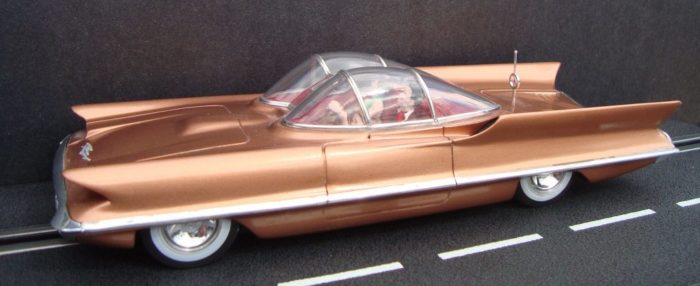
It looks like it can lift up and hover over the street like a future spacecraft. It’s pretty obvious that a 50’s Lincoln provided the basics of this concept with a touch of a jet fighter’s cockpit and fins that makes it hard to distinguish between the front of the car and the rear. It’s one of the most iconic classic cars of the decade.
GM Firebird II

A fighter jet may have inspired the designer of this concept, the second of four that included turbine-power. This was meant to be a concept of a future family car with self-driving capability due to wires embedded in the street.
Ford X-2000
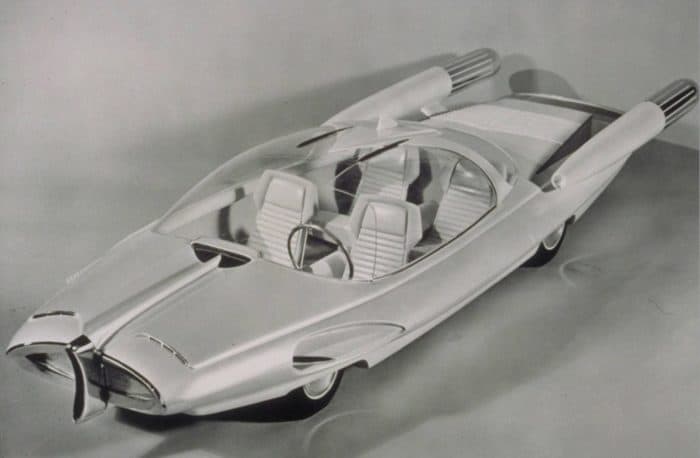
Designer Alex Tremulis no doubt also had a jet in mind when he created this concept. Tremulis was actually a famous designer of the time who actually did drawings of flying saucers for the U.S. government during World War II. This what he thought a car of the year 2000 would look like. Well, it doesn’t resemble anything I’ve seen traveling down I-95.
Cadillac LaSalle II

This Cadillac concept actually looks pretty reasonable like a two-seater Thunderbird or a British sports car from the 1960s (Triumph or MGB?).
GM Le Sabre
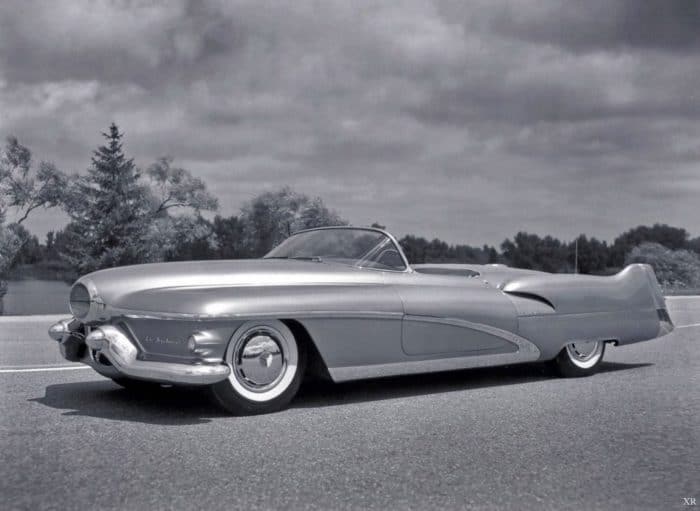
Harley Earl, the designer of the Corvette as well as other production models, conjured up this concept. The snout might remind some of the nose of a MIG jet and there are the ever-present tail fins that seem to appear on many cars that we’ve seen from the 50s and 60s. This car had some high tech features as well that have made it into today’s cars, like heated seats and sensor that detected rain and triggered the roof to automatically close.
Cadillac Cyclone
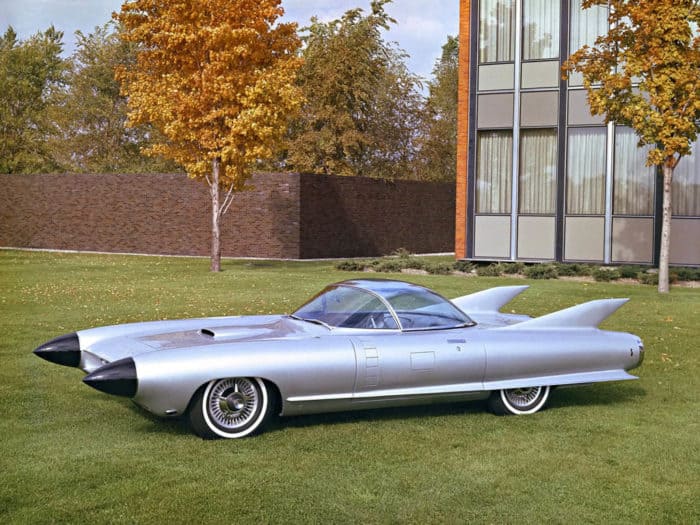
No, it’s not the Batmobile, but it sure looks like it. Harley Earl designed this concept, too. Those black cones up front actually contained a small radar that was to serve as an anti-crash detection system.
Ford Nucleon
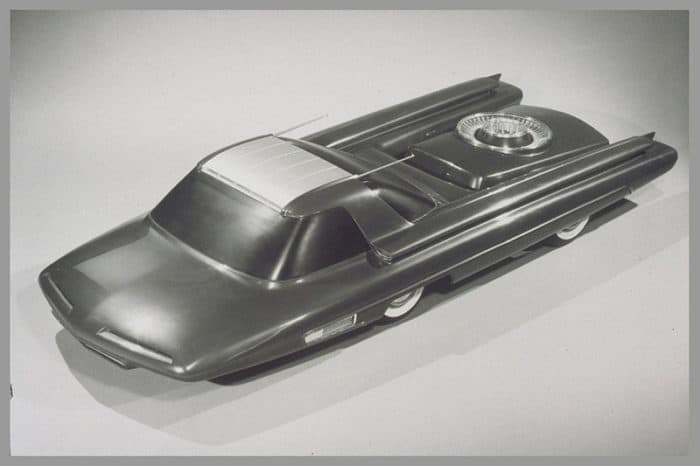
Let’s not forget that the 1950s was a time when nuclear power was forecast to run just about everything from our cars to the appliances in our homes. That box on the bed at the rear of the vehicle is supposed to be a nuclear reactor. Hence the name, the Ford Nucleon. It’s one of the most well-referenced 50s concept cars.
Alfa Romeo BAT 9

This car was designed as part of the Alfa Romeo BAT (Berlinetta Aerodynamica Technica) Program that strived to create a car with the best drag co-efficient as possible. Three cars were made over a three year period –- the BAT 5, 7 and 9.
GM Firebird III
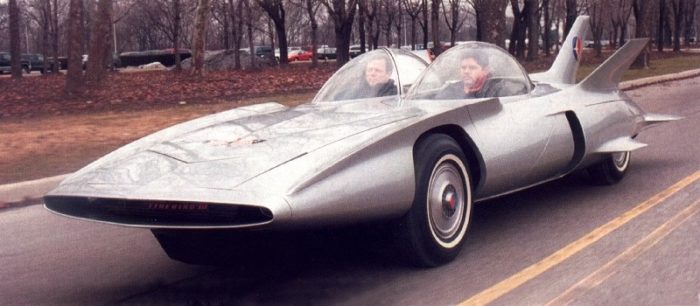
This copy of a supersonic jet had titanium skin and turbine power. The development of the shape of this two-seater was the result of hours of work in a wind tunnel. There are seven wings integrated into the car and they are actually functional. This is the epitome of a 1950s car!
Pontiac Club de Mer
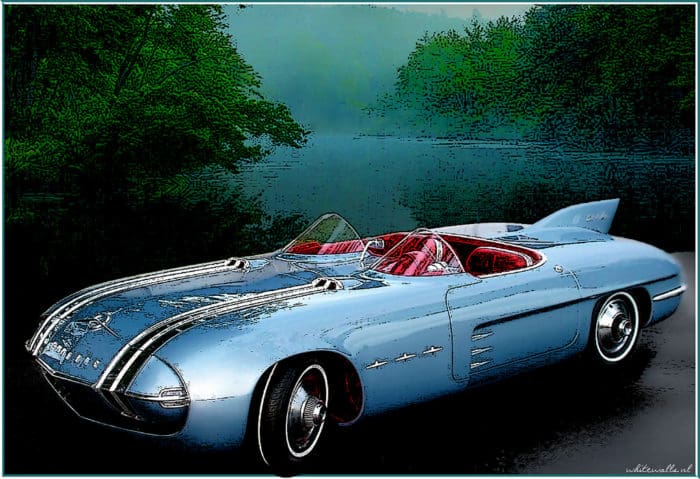
This aerodynamic tube that was only 39-inches tall featured one of GM’s newest and most powerful engines and honored the land speed record cars of the 50s.
While these awesome space age cars had plenty of promise, very few of their cool and quirky features made it into mainstream production. Sure, we’re not all living on the moon or riding around in atomic roadsters, but these 50s cars taught the industry a few cool tricks. So without further ado, let’s take a look at some of the coolest innovations from 1950s cars that are still being used in cars today. And before you ask: yes! We’re including other cool things rather than the usual go-to power steering and fuel injection stock answer..
9 Modern New Car Features Predicted By Old School Concept Cars
The ’50s and ’60s were the age of concept cars. Besides wild designs, designers predicted advanced features for the future, and they got some of these right.
Looking back, it appears that GM was more serious about advancing the state-of-the-art in automotive styling, while Ford focused more on outlandish designs and predictions of future technologies.
In fact the original Batmobile (TV Show) was a recycled Lincoln Futura concept car of 10 years earlier, purchased and upgraded by George Barris.
Hands-free Telephone – 1969 Buick Century Cruiser

The 1969 Buick Century Cruiser was conceived as an autonomous car, but not like those in development today. The Buick engineers at the time hadn’t considered computing power would allow for autonomous travel on all street, and not just controlled access highways with an embedded wire for the car to follow. Regardless, what the engineers did predict correct was a hands-free speaker phone in the car. The first mention of which installed in a car that can be found.
Proximity Warning System – 1958 Ford La Galaxy

While not functional on the Ford La Galaxy, the technology did exist for this system to have been operational – it just would have been very expensive and very heavy. Today, a proximity warning system – alerting the driver that he or she is getting too close to another car or vice versa is commonplace and available on many models of cars.
Heated Seats – 1951 Buick LeSabre
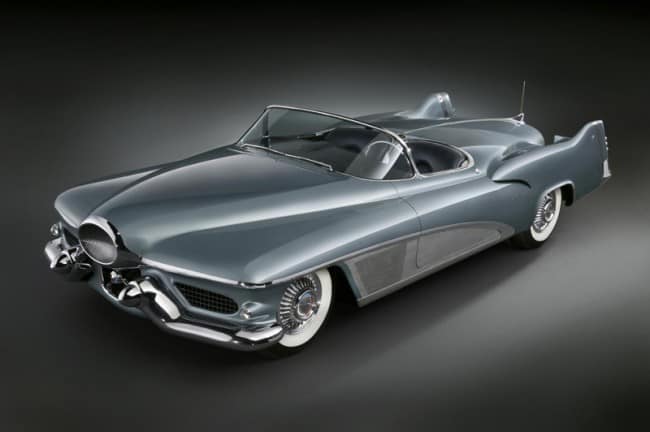
The 1951 Buick LeSabre is much better know for the contributions the design made to the styling of cars for the next decade than for any gadgets or gizmos, but one very practical advancement was included. Harley Earl drove the open LeSabre on the street for two years, so it’s not surprising that heated seats were invented for this particular car.
Aerodynamic Styling – 1957 Chrysler Diablo

Chrysler pioneered the use of aerodynamics in the short-lived Airflow sedans of the 1930s and bravely brought back the concept with the 1957 Chrysler Diablo. While the Airflow’s styling was determined by the wind tunnel and the result was a car few buyers found attractive, this time Chrysler shaped a car using the wind to develop a design both aerodynamic and pleasing to the eye.
In-car Navigation – 1958 Ford La Galaxy

What the 1958 Ford La Galaxy lacked in styling, in made up for in gadgets. The Ford engineers mocked-up a non-functioning radar guidance system, which would work like our modern GPS, except that it wouldn’t for any number of reasons. It would take 20 years before the first GPS satellite was launched, and now, of course, access to location data and more is indispensable.
Push Button Start – 1955 Ford Mystere

From our perspective today, push button start seems to have started with premium cars and slowing worked its way down to less expensive models, so that the feature is available on a great number of car models today. Not so, the first mention of a push button start was in the description for Ford’s 1955 concept car, the Mystere.
Rear View Camera – 1956 Buick Centurion

Among the advancements in the 1956 Buick Centurion was that the engineers installed a video screen in the dashboard and a wide-angle rear-facing camera in the back, creating the first such system in automotive history.
Rear Seat Passenger Video Display – 1955 Ford Mystere
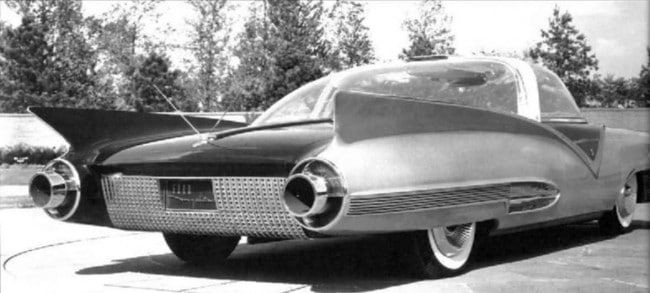
Perhaps one of the least attractive concept cars ever created (particularly when compared to Harley Earl’s GM designs) the 1955 Ford Mystere offered at least one glimpse int the future: a video screen for rear seat passenger entertainment. While and type of transportable media or games were still a few decades away, the kids could watch their favorite TV shows in glorious black & white. Check out the “rabbit ears” antenna at the back of the car.
Advanced Braking System – 1956 GM Firebird II

Though there’s no mention of the source, the aircraft-inspired GM 1956 Firebird II classic car was described as fitted with four-wheel disc brakes and an anti-lock braking system. Where some of the previous concepts were simply non-operational mock-ups, Harley Earl insisted that his “Dream Cars” be totally operational. Its possible that GM engineers adapted existing Dunlop disk brakes with Dunlop’s Maxaret mechanical ABS system designed for aircraft, and created the first advanced braking system (power brakes) for automobiles.
